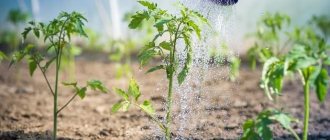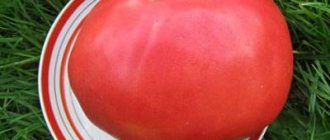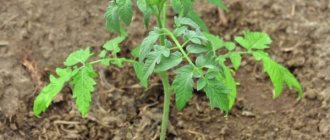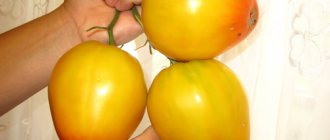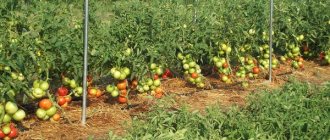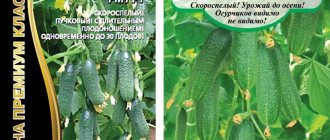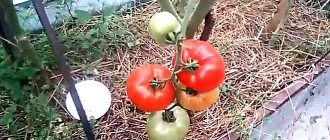Description of the variety
Fruit:
- Rounded in shape, flattened at the top and bottom, with medium ribbing;
- Unripe ones are light green in color; those that have reached varietal ripeness are pink;
- With dense, smooth skin;
- With tender, juicy pulp, with numerous seeds;
- The number of seed chambers is from 4 to 6;
- Low dry matter content;
- Large sizes. Average weight is approximately 300 grams or more.
Bushes:
- Indeterminate, non-standard plant, with a strong, well-leafed stem. With a powerful, developed rhizome;
- It reaches a height of more than two meters;
- The leaves are large in size, dark green in color, tomato-type, wrinkled, with no edge;
- The inflorescence is simple, intermediate type. The formation of the first inflorescence occurs above the 7-8 leaf, further ones at intervals of 1-2 leaves;
- The peduncle has an articulation.
Description and characteristics of the variety
Tomato Happiness F1 ripens in an average time - 110-115 days from the start of germination.
Characteristics:
- indeterminate tall hybrid;
- requires pinching and fixing;
- shoot height reaches 2 m;
- 5-6 tomatoes are knitted on tassels.
The hybrid is included in the State Register. Recommended for film greenhouses and greenhouses without heating.
It grows and bears fruit successfully in open beds.
Tomato subtleties:
- average weight 250-280 g;
- round and flattened shape;
- the stalk has moderate ribbing;
- the pulp is fleshy, sugary;
- the skin is strong, not cracking;
- The taste is dominated by sweet notes over sourness.
Tomatoes make aromatic, delicious salads. The results are colorful, thick ketchups, wonderful juices and soup dressings.
Tomatoes: advantages and disadvantages
The tomato hybrid “Russian Happiness” has the following positive qualities:
- Large fruit;
- High productivity;
- Immunity to major diseases;
- Possibility of long-term storage;
- Good transportability;
- Commercial appearance of the fruit.
REFERENCE: Characteristic features include resistance to fruit cracking at the genetic level. The hybrid also loves good watering and fertilizing.
The hybrid has no disadvantages.
Diseases and pests
Tomato bushes are susceptible to attack by mole crickets, spider mites and gnawing cutworms .
At the same time, parasites destroy bushes both in the greenhouse and in open ground. Spider mites are washed off with a concentrated soap solution . Many poisons sold in stores against this pest cannot be used, as they end up in the fruit.
Fighting mole crickets requires the use of toxic chemicals . Since it lives underground and destroys the root system, poison and traps are buried.
The gnawing cutworm, whitefly and other surface pests are eliminated using Strela or Phosbecid preparations.
The variety Women's Happiness is resistant to the main diseases characteristic of the nightshade family . In rare cases, bushes suffer from dry spotting.
The drugs “Tattu”, “Antrakol”, “Skor” and their analogs help to get rid of it. Top rot develops due to a lack of potassium. This problem can be easily solved by watering with potassium fertilizers.
Growing tomatoes
The hybrid “Russian Happiness” is grown mainly by seedlings.
How to prepare seeds?
Preparation of seed material:
- Since the tomato is a hybrid, planting material cannot be collected independently. Therefore, it must be purchased annually in specialized stores, only from trusted manufacturers;
- Since the seed material undergoes basic processing immediately before sale, it does not require any additional procedures;
- However, to increase the germination percentage, the seeds are soaked in a growth stimulator for 10-12 hours.
Sowing seed material
How to properly sow seed for seedlings:
- Seeds are sown in early March;
- Sowing is carried out in a common container, in disinfected, heated soil. It is desirable that the soil has a high level of acidity and is saturated with oxygen;
- The seed material is buried 2 cm, leaving an interval of 2-3 cm;
- The sown seeds are watered with warm water from a spray bottle and covered with a transparent film;
The microclimate formed under the film has a beneficial effect on the germination of plantings.
- Closed containers are taken into a room with a temperature regime of at least +23 degrees;
- As soon as the shoots emerge (after 3-5 days), the film is removed and the containers with seedlings are placed on a well-lit windowsill. At the same time, the room temperature is reduced to +18 degrees. This will prevent the seedlings from being pulled out;
- After the formation of the first pair of true leaves, they begin to pick the seedlings into separate containers. This procedure is necessary for the full development of the root system;
- Afterwards, the transplanted seedlings are fed using liquid mineral fertilizer;
- Water moderately as the soil dries;
- 14 days before planting in a permanent place, seedlings begin to harden so that they can more easily adapt to temperature changes.
Every day the seedlings are taken out into the open air, gradually increasing the time spent outside.
Rules for planting seedlings
Recommendations for planting seedlings:
- Seedlings are planted at the age of 50 days;
- They begin to prepare the soil in the fall. The soil is thoroughly dug up, removing all plant residues. It is also necessary to add compost, humus, and fertilizers;
- Planting is carried out in soil that is disinfected and heated to +25 degrees;
- Planting holes are placed at intervals of 50 cm. A handful of wood ash is added to each hole.
Features of cultivation
Sowing the seeds of this tomato for seedlings is carried out 60-65 days before the intended planting in the ground. Seedlings dive at the stage of two true leaves. When planting seedlings in a permanent place per 1 sq. m area it is recommended to place up to 3 plants, when forming into 1 stem - up to 4.
Further care for tomatoes consists of timely watering, weed removal, pinching, fertilizing with complex mineral fertilizer and preventive measures to protect the crop from diseases and pests.
If you grew Happiness tomatoes, please write whether you liked them or not. What was the yield and taste of the fruits like under your climatic conditions? How do you assess the disease resistance of this hybrid? If possible, attach a photo of the entire bush as a whole or individual fruits you grew.
Your reviews of the Happiness tomato and additions to the description will help many gardeners evaluate this hybrid objectively and decide whether it is worth planting or not.
Bush care
Further care activities include:
- Watering. Water tomato bushes only at the root, generously. Watering is carried out in the morning to prevent increased air humidity at night. For irrigation, take warm, settled water;
- Loosening. It is a mandatory procedure that improves soil aeration and allows moisture to reach the root system. Loosen after each watering to prevent the formation of a crust on the soil surface;
- Bush formation. Form a plant into one or two stems. However, experienced vegetable growers advise forming into two stems;
- Stepsonning. Stepsons are pruned once a week, removing all lateral shoots;
- Feeding. Throughout the season, 3-4 feedings are carried out, alternating organic and complex mineral fertilizers;
- Tying;
Since the plant is tall, it needs to be tied up. Otherwise, the stem may break off under the weight of its own fruits.
- Mulching. Mulched soil allows for a long period of moisture retention and also protects the plantings from weeds;
- Ventilation. When grown in greenhouse conditions, the room is ventilated every day. This will prevent the occurrence of fungal diseases.
How to grow seedlings?
Tomatoes of the mid-early, indeterminate group are recommended to be grown through seedlings. It is kept in a greenhouse until the first flower stalk. Sowing is carried out 70-75 days before planting in the ground. The greenhouse period lasts up to 60 days.
For sowing, you need to prepare seeds, soil mixture and a container. The seed is kept for 20 minutes. in antiseptic, bring to ripening in a damp cloth.
Sowing is carried out when the seedlings swell and the peel begins to separate. To stimulate metabolic processes in the core, moisten the napkin with Epin solution, 2 drops per 200 ml.
The soil mixture is prepared from humus and peat. Organic fertilizers are used in the same amount. Sand is added to the mixture, ¼ part. The soil is left in a warm room, at a temperature of 20-23 C.
View this post on Instagram
Publication from OKSANA
